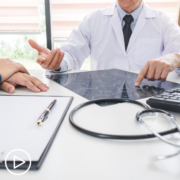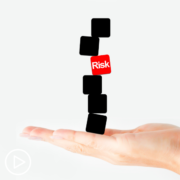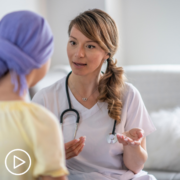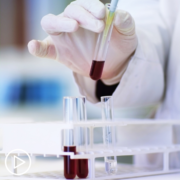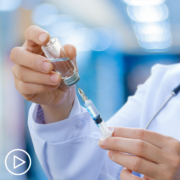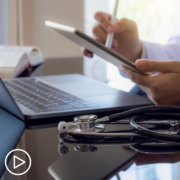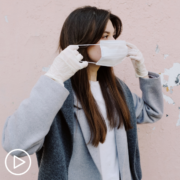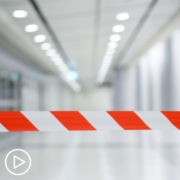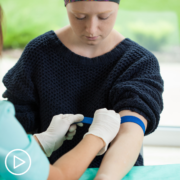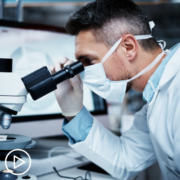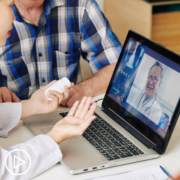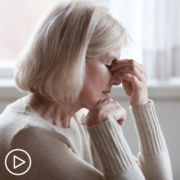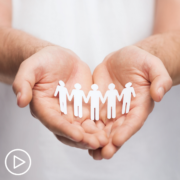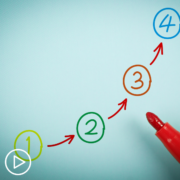Increasing Treatment Access for Every CLL Patient No Matter Location from Patient Empowerment Network on Vimeo.
How can CLL patients get the best treatment no matter where they live? In the era of COVID-19, where social distancing helps to avoid risk for acquiring infections, how can patients, care teams and health systems provide quality cancer care during the pandemic and beyond?
Watch as a panel of experts and a CLL patient discuss innovations around practical tools such as mobile applications that allow you to track your own information to help improve access to treatments. Learn about tips for self-advocacy, the importance of connecting with a CLL specialist and empowerment for increasing your digital literacy.
Related Resources:
Transcript:
Dr. Farrukh Awan:
Hello and welcome. I’m Farrukh Awan from UT Southwestern in Dallas, Texas. I am a CLL doctor, I take care of patients with CLL. I also perform a lot of research around patients with blood cancers, leukemias and lymphomas, and with one goal to make small advances in the field and hopefully eventually cure this cancer. So, I’m very excited to be on today with all of you and look forward to having a nice discussion with all of you. I would like to start off by introducing the participants of this discussion with me, and I really thank them for their time this afternoon, and hopefully you guys can all enjoy them.
So, I’ll start off with Dr. Kathy Kim. Dr. Kathy Kim is an associate professor at UC Davis in California. She is a very well-established researcher there and the faculty member there, and she’s also the director of the Health Innovation Research Center in the UC Davis Center for Health and Technology. Welcome Dr. Kim. And I also am very happy and excited to be introducing Mr. William Marks, who’s a renowned Jazz musician, who happens to be one of our patients, and we’re very excited that he is joining us today from Dallas. So, thank you all for being here today, and we really want you guys to participate, send in your questions in the chat box or whatever you feel comfortable with, raise your hands, and we can definitely try to get to as many of them as possible.
So today, what we will talk about is how CLL patients can get the best possible care regardless of where they live, where they are, or regardless of the pandemic, we feel that there is a lot of disparity in the care that our patients can get, and we are all familiar with a lot of data that came out recently and also in the years past, which consistently showed the same trend that people in different parts of the country with access to different resources get different levels of care, which I feel that in 2021 it’s unfortunate because we feel that it shouldn’t matter where you are, the care should be consistent, unfortunately, that’s not the world we live in.
So, there are certain issues and concerns and challenges that we face, and we want to highlight some of those and talk about them during the next hour or so. We also obviously are dealing with a pandemic, which complicates the issue even more, you know for the first time, we’ve had an opportunity to deal with this issue of remote help or telehealth or remote monitoring of patients for an extended period of time.
So we’ve had the chance now, ’cause people used to talk about this all the time, but for the first time, we’ve had really an opportunity to really assess the situation and come up with solutions that work for as many patients as possible, so a lot of new things are happening in the field, and a lot of challenges that we have encountered over the last few months, and we welcome some of them, so we’ll talk about some practical tools, we’ll talk about some innovations, and hopefully we can have a nice conversation around that.
So, before we start formally, just a few housekeeping things, so like I said, 30 minutes in discussion of different topics that we felt might be a benefit to you, and then the rest of the time will be dedicated to your questions. Please remember to keep your questions generally broad, we don’t want to know your specific health information ’cause this would be shared as a video format, later on we will have a transcribed format of this presentation and this discussion. So, it will also be available on the website, so please don’t share anything that you would not want to share in a public forum.
I will also try to answer as many medical questions as possible without very specific references to your situation because there’s always so many things that we are not aware of, so don’t take this as formal medical advice, please. This is just a suggestion, and I’ll give you the suggestions to the best of our abilities, and the same goes for Mr. Marks and Dr. Kim. So, let’s start off, we’ll start off with the first domain that we kind of selected we felt would be helpful ’cause it’s very relevant to what we are going through right now, and that’s the COVID pandemic.
So COVID has been a major social inconvenience, it’s a very unfortunate situation that we’re all dealing with right now. Unfortunately, in our country, the incidence of new infections has gone down, but we’ve lost a lot of people and it’s happening all over the world. The third wave that people keep talking about or the second wave is happening as we speak in multiple parts of the world, and a lot of people are still dying unfortunately and still suffering from this, so we do see some light at the end of the tunnel hopefully, with more vaccinations, things will improve.
So, I think the problem that we have encountered during this era over the last year and a half or so, and possibly for the foreseeable future, is how can patients in this challenging time get the best care? How can healthcare teams and can physicians, nurses, APPS, nurse practitioners, physician assistants, how can they work as a team to provide the best possible care to our patients without compromising quality?
So, we will start off with Mr. Marks, and let’s see what his journey has been like, ’cause we kind of know that he started before on his journey before the pandemic and during the pandemic. So, I guess, why don’t we start off with you, William, and see how you want to capture your journey, what happened with you, how you felt about the changing dynamics of a patient-physician relationship, so let’s start off with you and then see what you feel has happened and impacted you during this pandemic?
Mr. William Marks:
Well, my journey started around 2015, real quick, briefly, I was healthy, I went to my doctor every year, got a physical. At this physical, my doctor called me back and told me I needed to come back and get other further blood work and long story short it started my CLL journey. I had a physician, my physician referred me to an oncologist, and I already made up my mind how I wanted my treatment to go, and they wanted to start a treatment on me that I just was not really ready to agree to.
And so, I had a friend that was a physician, and he referred me to Dr. Froehlich at UT Southwestern and he immediately agreed with me and thought, we should wait on treatment for a while because I had no signs of CLL at that time, and then Dr. Awan came about, and what I loved about Dr. Awan is, I did tell him how I felt about what my treatment should be, what I really didn’t want to get into, but he told me that he really didn’t want the treatment, wanted me to take treatment that I thought he was going to tell me I needed. He thought that we needed to wait a while, and so we waited until around I think Dr. Awan, 2017 or 2018, then he started experimental treatment on me and it really works for me, and he can explain to how it has been successful for me. But you have to trust the doctor.
And also, during the pandemic, I had such a trust in my doctor that talking to him via ZOOM on some of my patient visits was no problem for me, and so that’s kind of my journey. I had an oncologist, they wanted to do a treatment on me that I really didn’t agree with, and I found a doctor who first started out saying, “We don’t want to do this right now, we just want to kind of see what happens” and then to me, it turned out successful.
Dr. Farrukh Awan:
So, what I’m hearing you say is that you would recommend that anyone with CLL should at least try to get a second opinion from a person who specializes in the field, is that accurate?
Mr. William Marks:
Very accurate, very accurate. And whatever your belief system was, you know there are certain treatments out there that I just didn’t believe that I wanted to go through at first, and it’s a choice, and I don’t know Dr. Awan, if you really wanted me to delve into that or not, and you know but he told me before I even said that, and it just made me feel like he’s the doctor for me, he feels the same way I do, and I haven’t even told me the idea, so it’s very important that on this journey that you pick a physician that you can 100% trust.
Dr. Farrukh Awan:
So, I think just a little bit of a background, he mentioned that he’s on an experimental therapy, and just to clarify that a little bit more, Mr. Marks got on a clinical trial with a new combination of immune therapy, which worked out very nicely for him. So that’s another pitch for asking about the clinical trial as a patient. I think patients need to be their own advocates; they need to ask for those. Push the doctor a little bit.
Had he not pushed the first doctor, he probably would have ended up with chemotherapy. Now, some people can argue that that may not be necessarily the wrong thing to do, but we have other options which might be even better, or other options which are definitely less toxic, so pushing us, if he pushes me and if my patients pushed me, it pushes me to find the next best thing, so I think it’s a mutual thing, I benefit from patients like him, and hopefully our patients benefit from the doctor being engaged and receptive to their needs.
Dr. Farrukh Awan:
So, I completely agree with this. I think we’ve seen this over and over again, that sometimes if you’re getting a certain plan made already, and if you have any doubts, any questions, and if you feel that you read somewhere about some other thing, you should at the very least, ask the question and you should always make an effort to find a CLL specialist who might be close to you, and if there isn’t a CLL specialist close to you, it’s always an option right now to ask for telehealth with a doctor who might be a couple of hours away or in another state.
Because we now have access to those resources.
So, this is the nice segue, so we’ll get Dr. Kim in next. You know, with so many patients nowadays who are worried about their cancer care and how that will continue, and especially now with remote monitoring. How, what kind of tools do you have deployed and used, what would be your recommendations for us and how we can make us some of these new innovations and new methods to provide the best care for our patients?
Dr. Kathy Kim:
Oh, thank you so much, and I’m glad to hear where this conversation started with you, Dr. Awan and Mr. Marks, because I think even when you’re thinking about using technology, again, it’s not one-size-fits all, it is what the provider is comfortable with and what the patient is comfortable with, and what you two can work together to improve your care. So, I think there are a lot of innovations that have been developed over many years, but this past year under COVID, we saw an acceleration of people adopting them because it was out of necessity that people didn’t come in to a setting where they might potentially be infected or to infect others.
So, we certainly saw a huge increase in telehealth, which has been virtual visits, like we’re doing right now, we are virtually visiting with each other or telephone visits, so there’s been a huge upsurge in the number of hospitals and clinics and practices that have been able to implement telehealth with their patients. But there are other tools that again, have been in development that are now starting to take off under the last year, and those are remote patient monitoring devices, these are either specific medical devices, like blood pressure machines, glucose meters, some heart monitors, sleep monitors, you know things that, devices that check your oxygen saturation.
So, there are many medical devices that are for use in the home, that are either covered by insurance or people can buy them at the drug store, and what has really come about this year is the ability to connect the data from the device you have in your home to your provider, so that’s been in place, but we really haven’t implemented it very many places, and now lots of places are allowing that connection to happen. So, the patient can use the device in their home and get it connected to the internet and have it sent to the hospital or to their doctor, so their doctor can be watching the data and also monitoring them, so that’s one really wonderful piece of progress that we’ve had in the past year. I would say the third area that again, has been around for a while but people haven’t used it so much has been mobile applications.
Dr. Kathy Kim:
So, these are basically software that you can run on your smartphone or you can run it on a tablet or a computer that let you track your own information. So, I know CLL patients and many cancer patients have lots of documents from all the treatments, from all the visits that they have had, and it’s a challenge to manage all those medical records because you might go to multiple places, right? You’re not always going to the same place.
So, now there are many applications that are integrated with the record systems that your hospital or doctor has, where you can aggregate all of your records in one place, and that way when you go to talk to another provider or have this second opinion or a consult, you have access to all your records that you can share. And then you can also track things that are important to you, so maybe you want to track how I feel, what my symptoms are under certain kinds of medications or when I do more physical activity, do I get more tired or do I actually feel better, you know track and by taking my other medications, and for many of us, just remembering to take your medications every day is hard enough if you have several medications and they’re at different times, you might not remember, did I take that one already or do I still need to take it?
And so, these applications can also set up your medication schedule and help you to track whether you’ve taken them or not, so there are lots of these tools now available where you can start to manage all of these things and share that information with your doctor.
Dr. Farrukh Awan:
I really like how you went through all of them, couple of things that I have noticed, and maybe you can comment on this too, one is, what’s the financial cost to having access to those tools? So that’s the first thing. So is it going to be financially difficult to let’s say, get an app or download an app, which might have a subscription service, attached to it, so that’s the first question that I might have. And the second question is then, this is something that I run into every day. A lot of my patients are older.
Some of my patients live on farms, a couple of hours, three, four hours away from Dallas in a relatively rural area, east or west of us in north Texas, and you know those people may not necessarily have access to broadband, they may not have access to high-speed internet. So, they may not be able to get online, or if they do get online, the connections are not the most perfect, so it’s always, the video is not pretty good, or they frankly, may not know how to operate, they don’t just don’t feel comfortable operating these devices or the tablets or phones, even though they might use them for making calls and texting, but they may not necessarily be very conversing with them or very at ease with them, so are those options really difficult for our patients to use?
Dr. Kathy Kim:
Yeah, so you’ve mentioned three really key areas, cost, connectivity, and what I will call digital literacy or digital familiarity, those are really three key areas that we need to address for anyone who wants to use these tools to be able to use them. So, cost is the first thing, most mobile apps are fairly inexpensive, and if you’ve downloaded anything from the Apple Store or the Google Play store, almost everything is free, or a few things might have you know $2.99, $8.99. Some of them do have subscription fees.
So, the app itself is probably the least expensive part of it. The more expensive part is, do you have a modern smartphone that can actually, where you can download that up or do you have a modern tablet or a newer laptop that can actually use apps, right? Not just software, but apps, those devices is where the cost really comes in, and you know if you’ve got any kind of device, it’s every couple of years, you have to replace it or upgrade it to kind of keep it up-to-date. So that is definitely a barrier of the cost of the computing device or remote patient monitoring device, and that is where we really need to collaborate in the industry with our hospital systems and our provider systems, with our legislative representatives, with our insurance companies, to provide low-cost access to the devices.
The third thing is connectivity, which is both cost, and it is a cost as well as an accessibility issue, and for most of the uses in healthcare, as you’ve mentioned, we need to be able to do video, we need to be able to connect to the devices for data, and that means we either have to have a cell phone data plan, a mobile data plan that can run data on your phone or your tablet, or you need a broadband connection in your home, an actual Wi-Fi plan that comes installed. You need one or the other.
And again, those, either of those options are quite expensive, if you do video visits, it can really eat up your bandwidth if you’re on a low band, low bandwidth plan or you’re paying for the minute or by the bit. It can become very expensive, so we have to have a cost-effective plan available to people, and again, there’s lots of policies or proposals, to be submitted both at the state level, and there are federal programs that are actually now subsidizing. So specifically, under COVID, provider organizations can apply to the federal government for special funds to offer telehealth help patients, so many providers have bought tablets or other remote patient monitoring devices or things like that, that they can give out to patients.
Which brings us to the third thing that you mentioned, which is digital familiarity or digital literacy. We have to help people learn how to use these. So even if you use a cell phone, it’s different using a smartphone, right? The apps are different, the navigation is different, how you touch your screen is different, how these applications actually work, and how to get the data from your own device to a provider, to your doctor is a whole another set of skills, right? Do you have to pair these devices, do you have to register an account and have a password?
Do you have to approve your doctor to get access, there’s all these questions about how you would actually do all this and this is where organizations like the Patient Empowerment Network, that I know does a lot of effort to help patients more how to use technology, as well as the research that we have been doing at UC Davis in the community about how to support patients overcome all these barriers becomes really critical, we have to actually work together to make sure all three of these issues are addressed so that everybody can have access.
Dr. Farrukh Awan:
So, you know, excellent points. And thank you for sharing with us. I think that what I would like to stress is, patients need to be advocates for themselves, and if you are having issues or difficulty in connecting with your provider via these remote tools that we have, like Dr. Kim mentioned, we have access to resources that can be provided to our patients in any major cancer center, any major university setting, and a lot of larger practices have access to these resources that can provide these facilities for our patients, so that it makes it maybe less burdensome, more accessible and people can avail those resources and get benefit from them. So, let’s go to Mr. Marks, so what about your journey?
‘Cause you started off by being able to see the doctor in person, you know somebody who can feel you on lymph nodes, you can feel your spleen and see how big they are, and then to go from that to being on video, obviously, I’m assuming that prior to the pandemic, you did not have a lot of interaction with this video platforms for medicine encounters. So how was your journey? Did you have a hard time in dealing with that or getting used to it? How did you open it?
Mr. William Marks:
I really didn’t have a hard time with it. Under the circumstances due to COVID, I understood that we have to go this route, but I would go to a facility to get my blood work done, you would read my blood work and over video you would tell me how my blood work was going, and it just gave me a sense of comfort and ease. It’s already stressful to go through a pandemic for all of us, but to also be dealing with CLL at the same time can be pretty traumatic for some patients, so I’m saying it was pretty comfortable for me because I knew I could go get my blood work done, you could read my blood work, and you could talk to me about what, you could assess it and tell me what I needed to do. So, it was really a comforting thing for me.
Dr. Farrukh Awan:
Awesome, so that’s always great to hear. And I would also like to add that a lot of times in certain situations, my patients are not comfortable with using the platform, they don’t know despite all our best efforts, and in those cases, I encourage them to at least talk to me on the phone, make an appointment, talk to me, so that way you can at least get undivided attention. We can talk about your symptoms, and at the very least, we can say, okay fine, you can go to a lab for blood work close to home, and then we can at least look at the blood work.
I can talk about the symptoms, I can talk about if you feel a new knot or if you feel that you have another new lump or bump, so those are things that I do encourage that at the very least, there are ways to connect via telephone, the old-fashioned way nowadays. And that can also provide some comfort to our patients and they can also benefit from using this old-fashioned tool, so I think this is also, this is great. So, let’s keep going on these and access to care. Another issue that we have seen is that some of our patients and we live in a town that has a substantial percentage of Hispanic-speaking or Spanish-speaking people, so we actually have access to a lot of resources and a lot of options for those patients, but there might be some limitations in people who don’t necessarily speak English as the first language, so what kind of tools do we have for those people, what kind of resources can they access to? So, Dr. Kim, anything for those patients?
Dr. Kathy Kim:
Yes, and we have really made an effort in our own research to any of the resources that we provide, the mobile applications that we use are available in multiple languages, and I will say Spanish is the most common one that we are able to support. Of course, there are many, many languages spoken in the United States, beyond English and Spanish that we do, we are challenged when we try to find other resources or applications that can be in Chinese and Korean and in other languages. It’s really challenging.
So, in our own work, we have developed applications, and this is in research, so these are not things that are necessarily available in practice. We have developed applications for example, for care coordination for patients undergoing chemotherapy or to support shared decision-making at the beginning of your cancer journey between a patient and their family and a clinician, and when we develop those applications, as I said, we, obviously, I don’t speak Spanish, I only speak English, so I’m limited as to what I can develop. I can develop it in English, but then we always try to co-design it with clinicians who speak that language and with patients, so we do a lot of co-design with patients so that when we create it we’re making sure that it seems appropriate when it’s produced in other languages, and then we always test it with people who are native speakers in that language as well, so that’s one.
So many of the educational resources, our website information, our mobile applications, there is no reason why we can’t have those available in multiple languages. I think it is more challenging when you’re trying to build a relationship with a provider, with your doctor or with your nurse, or nurse practitioner and the patient don’t speak the same language, and then we have to rely on interpreter services. And I will say that that has not quite made the leap that we’d hoped with telehealth, to integrate an interpreter into your telehealth visit is quite challenging, and I’ve heard of doctors and patients being on a televisit and then the doctor calls the interpreter on their cell phone and tries to put that speaker up to the speaker on the computer, and that it’s not the best experience for anybody. So, that is an area that we would really like to work on, how do you have interpreter services really integrated into telehealth so it’s smooth for everybody.
Dr. Farrukh Awan:
And let me share my experience, just this week, actually, on Monday, I was in clinic and we frequently have patients who speak Spanish, and we have in-person Spanish interpreters that are readily available, so one of my patients was a Spanish speaker, so I had the interpreter in the room with me, so that interaction went really well, the patient’s daughter was also obviously able to interpret some of that, so it was a fairly easy conversation, we explained, we talked about treatment options and what the plan is, so that went really well, My next patient was a Vietnamese speaking patient, so we don’t have those in person, so my nurse got me this iPad, which was on a mount, it’s like a dolly that can go from room to room, and I turned it on and I was expecting some issues and they basically had a screen for me saying what language do you want, and I said Vietnamese, and then literally 30 seconds I was connected to a Vietnamese speaking interpreter, and they were able to see me, see the patient and the patient was able to see them. So, it was almost like having an interpreter in the room.
And my third patient, this is where it got interesting, ’cause I did not think that I would have that there, ’cause they spoke Macedonian, ’cause they’re from Bosnia and that was interesting, very nice people, but they just don’t speak English, so I got on the same platform and I hit the other button and they said, what language do you want? And I said, Macedonian, and they connected me to a Macedonian speaker, and it was actually pretty straight forward, and I think the patients appreciate it, I think that the family members appreciate it if you talk in their own language. I feel that most of patients in that setting are able to understand some English, but if we try to converse, I feel that sometimes the message that I’m trying to convey may not get through to them like I would like to, and I think that’s why it’s always good to have an interpreter, even if the family member is there in the room? I think it always helps to have an interpreter in the room, in the event that you have to explain certain medical terminology, so my experience with this one application that our hospital subscribes to was very, very good, so I did not have to hold up my phone like Dr. Kim was mentioning. I hate that.
And to communicate to the patients real-time with the person who was actually able to see all of us, so that was my experience recently, and I also found out that actually there are certain apps that if I want to print out a certain form or a certain patient education material and give it to the patient, okay, fine, this is the treatment you’re getting, these are the side effects, this is what to expect, there are options for translating it because they are already translated.
You just hit the language you want, and that prints out the material in that language and you can give it to the patient to read, and I feel that that was a good resource to have. Similarly, being involved in multiple clinical trials, I feel that that is sometimes challenging option for a lot of patients, but I just want to reassure everyone that all you have to do is ask. You can ask for a form in a specific language and it’s my responsibility, it’s my job to make sure that that translation is available to you so you can read it in your own language, and that is a service that is provided routinely by our cancer center, and I’m sure by a lot of other major academic centers and cancer centers in the country.
So, just I’m trying to wrap this up. I think there is a lot of really exciting things happening in the field, and we would like to get to some of these questions in a little bit, but before we do that, I wanted to ask, William, one thing that we run into is, is that as a patient, when you go in and see a doctor, you are likely to be overwhelmed or intimidated by that person in the white coat, and if the doctor comes in and say, Hey, Mr. Marks, you need X, Y, Z chemotherapy, how do you say no to that? How do you get out of that situation in a nice way, so you don’t offend anyone or do you even care? How was … you changed doctors and you sought another opinion, which is a very difficult thing to do for a lot of patients. How did you manage that? Was it your experience in the healthcare field? Or what made you do that?
Mr. William Marks:
Just a feeling that I had. A feeling that I had on the service that I was getting, and I had told my family when I was diagnosed with CLL some of the treatment that I would not take. And when this other doctor just right off the back said, we need to start you with this treatment, I’m like, well, I have no symptoms, I had no swollen lymph nodes at the time, I’m like, I don’t think that’s good for my body to start this off right now, what will my future be? So, I just quit going, I just quit going to that doctor and researched and asked questions and found the doctor that was right for me. So, I would tell anybody, this is your life. And when I was diagnosed will CLL, I made up in my mind that I was going to fight it, it wasn’t a death sentence for me, and I was going to find the best care I could, and that’s what I did and I think it worked out real well for me.
Dr. Farrukh Awan:
Awesome. So, I think that we cannot stress that enough, it has been studied extensively, it has been shown consistently, it has not just been shown for CLL. It has been shown for breast cancer, it has been shown for prostate cancer, so to give you examples very quickly, the prostate surgeon who does a higher volume of surgeries through a robot or robotic prostatectomy is what it’s called, those doctors who do 100 or more surgeries in a year have better outcomes, similarly for breast cancer patients, if they get care under a best breast cancer specialist have better outcome.
Similarly, for CLL, it has been shown over and over again, that if you go to a CLL specialist or somebody who specializes in that field, you not only get tested better, but you also have better survival outcomes, which is very hard to show in a cancer that usually takes a long time to cause problems like prostate cancer or CLL, it’s the same because these are chronic cancers. They can go on for a long time, but even in that setting, if you get taken care of by a CLL doctor, it has clearly been shown that your survival is better as compared to when you’re taking care of a very competent non-CLL doctor.
So, it’s not necessarily anything wrong with the doctor, it’s just that the guy who’s doing this every day, day in and day out and that’s the only thing he does. There are teams of people around us who specialize in this, my nurses see only patients like you, my dermatology sees only patients like you with CLL. My pathologist sees anything, so my whole team is very used to taking care of a patient in that setting, and I feel that even if it’s not me, it’s my whole team that provides the care that is needed for the patient, and I think that’s the whole point.
That’s where the specialist comes in, not saying anything bad about the doctor that sees every cancer, but they just do not have the volume of patients with your disease to be experts in that, because CLL is not a common mission, it is the most common leukemia, but it’s definitely not the most common cancer, it’s not even in the top five. So, you know the most common patients we will see is breast cancer, lung cancer, colon cancer, prostate cancer, so the general oncologist, that’s what you will see, and once every three or four months, they will see a patient with CLL versus in my clinic, I will see 40 patients a week with CLL. So completely different ball game.
This is why patients need to be advocates for themselves, push the doctors a little bit and hopefully get better care. So, that will transition to some of the questions that we have, can Dr. Kim, any insights about non-tech tools, born out of the pandemic that might be a model for future cancer care? That’s interesting, ’cause I feel that we may never get, go back to the pre-COVID era, so people have started calling it BC or AC, before COVID, after COVID. I don’t always like connecting to the popular platforms and would like to explore other easy to use tools. So, Dr. Kim, what do you have to say about that?
Dr. Kathy Kim:
Yeah, there are a number of tools. First, I want to re-emphasize something that both of you have said, which is, patients should be advocates and they should ask, what can you give me that can help me through this process, and what tools do you have for me to communicate and stay connected with my doctor? So, you should ask, are there ways for me to get in touch that are not calling, just when the clinic is open, do you have a secure messaging system? Can I message through the patient portal?
Do you have an app that’s available for that patient portal that I can download? Do you have any other research studies where they’re trying as the same way you said patients should ask other clinical trials, are there research studies using technology for cancer patients? So as much as outreach as we do to try to recruit patients into our technology trials, oftentimes somehow patients don’t hear about it, so if you ask and you’re interested, is there a study like that where I can get access to technology to try it out, to see if it will help.
So, you should definitely be an advocate, but I think some specific tools that patients should be asking about that are already available are things like, how can I get an electronic copy of my care plan? Can I get that through the portal or do you have an app where I can download my actual care plan? How do I get electronic copies of my medical records?
Where can I get them? And how can I store them safely? How can I connect to other patients in my area? Do you have an online patient support group? Do you have any services at the hospital where you connect patients like me as close as possible to the kind of patient I am, that you can make a match for me to talk to someone by using either ZOOM like this or an online support group or just one-on-one match maybe introducing by email.
These are all technological tools that already exist that are not, that should not take a huge amount of time for someone to learn a new technology, but you want to make sure that it’s something that your hospital and your provider feel comfortable have tried and know that it’s secure and safe and useful. You don’t want to go off and do something that your provider has no connection to it, you really want to keep these as integrated as possible, and in that way, I think in the future, we won’t just rely on Mr. Marks, you have to come in to the hospital for every single thing. We want to give you all these tools, and then you and your doctor can decide which things you really have to come in person for and which things you can access online.
And so that is the conversation that every time you go talk to a new provider or go to a new hospital or clinic, you should ask, what technologies do you have that are available to the patients? And that that’s how I think we’re going to push forward our new model of cancer care, which I will hope will use the technology to allow patients to collaborate with their healthcare team more easily and more seamlessly and in a way that’s safe and secure.
Dr. Farrukh Awan:
This partly answers the question that Christine raised, that she’s in Hawaii and she wanted to get an opinion at California, and that insurance company denied her referral to the doctor in California, so for Christine, what I would say is exactly like Dr. Kim was saying that we should definitely ask your insurance company what kind of tools you have for remote encounter, I think you should press them a little bit, and if they say absolutely not, we are not covering that. So, then I think in that case, the doctor sometimes can make a suggestion or write a small note to the insurance company that I would be okay with sending the patient for a second opinion.
The third thing you could do is there are lots of societies now in groups now, where you can ask for a remote consultation, and I actually do that for my patients, I get invites from different groups and they say, okay, fine, doctor, can you set up a 15, 30-minute telephone consult to a third party. So, they don’t charge you anything. They don’t charge me anything, they just set up a time and I volunteer my time, and I can connect with my patients in New York and wherever they are, and then if they decide that they want to come down, that’s up to them if insurance approves it, if they want to get care locally, that’s fine, but at the very least, that allows you to talk to somebody face-to-face, they can talk to you about your specific situation, they can suggest what kind of tests you might benefit from.
So, there are all of these tools that are available, I think you just have to search for them a little bit on the Internet at these different societies which provide that service of remote consultation. I know that I do that. The other question, I think they’re all similar to these questions, and I’ll try to go through them quickly, is that well, if I’m sick, what happens if I’m far away? So, a lot of times, we can call in prescriptions and medicines on the phone to prevent you from having symptoms from the disease, and that can be used at home. It’s always good to have a local doctor or a primary care doctor close to where you are, so in the event that you have to get admitted to the local hospital, you have that connection with them.
So, it’s always nice to have one quarterback directing the care of your cancer, but at the same time, having somebody local would also be helpful in these emergencies, hopefully, we won’t be able to have the way the treatment is evolving, I think you would have less and less of those problems, because treatments are so well tolerated, but occasionally, obviously, you can have problems which might need local consultation, and that’s perfectly fine.
We always transfer our patients to the main center once they get admitted to the local hospital for any reason, if that’s required. So, we can work very closely with the local team, and I think that’s really what you want, you want a doctor who’s willing and able to do that. And similarly for CAR-T patients, there was another question that was asked. CAR-T is much more complicated than your regular chemotherapy or immune therapy or the new molecules that we have. I think that’s something that we would like to stress that for CAR-T therapy, since it’s so specialized, it’s always important to have the guy who did it call the shots because testing is specific, the management complications are very unique to CAR-T, so I think that is an option for remote monitoring for those patients but they have to be very closely followed, we can do that.
And so similarly, I feel that right now with the way things are, it should not matter if you’re in a rural area or an urban area, I feel that everyone should have access to all the modern therapies, and people should be able to benefit from them equally. You just have to ask, and there are experts in pretty much every state, and if your state doesn’t have an expert, you can try this remote or remote consultation business.
And then one last thing that I would like Mr. Marks to chime in this is how it works. So, when do you know when to get help? So how did you know that you needed help for your CLL when you did take the decision to go ahead with treatment, obviously one part is the physician telling you but what about your own self, how were you able to know on your own that I think I might be getting to the point where I need to do treatment?
Mr. William Marks:
Well, I started from the beginning, I started doing everything. I started reading everything I could, I started trying to research everything, I changed my eating habits, I lost weight, I did everything I could personally, but I knew that the CLL that I had, I could not conquer by myself and alone. And so that’s when I knew, you can do everything you can, you can take all the herbs and supplements and everything you can, but then CLL is something that you really like you said, you need someone who specializes in it to know. And like I’m saying Dr. Awan you can let them know how I’m doing right now. I know HIPAA and all that, but I’m really doing real well after six years, and I do believe that Dr. Awan saved my life.
Dr. Farrukh Awan:
Well, thank you for that compliment. I think we’re just a tool in this whole process, but my suggestion and recommendation to everyone is, it’s half and half, it’s 50/50, it’s a partnership. Half of the times it’s the patient listening to their body, looking at the lumps, seeing how they feel, and half the time it’s us looking at the blood work, looking at the lymph node size, the spleen and all of that stuff and putting it all together before we make a decision. So, these decisions are not made in isolation. It has to be made as a team. And this is exactly where trust comes in. So, with that, we will try to wrap it up, and so any last thoughts, we’ll start with Dr. Kim and then William, I’ll ask you to just give your thoughts so that our audience can benefit from those.
Dr. Kathy Kim:
Thank you. It’s really been a pleasure to be part of this conversation with all of you, I think my last thought is really for patients to see technology as a tool that can help you communicate, organize information about your health and be as proactive as possible for the things that you can control, as Mr. Marks just talked about all the things that you can do to improve your health. But be an advocate for yourself and ask your hospital, your doctor, your provider organization, what technologies can you give to me, what technologies can you offer me, and even if they don’t have a whole lot, at least they know that you want it, and then they may then invest in tools for patients like yourself, so first, use the technology that you’re comfortable that your doctor is comfortable with, and second, be an advocate and demand the things that you want to have access to.
Mr. William Marks:
Well, I would just like to tell everybody, first of all, thank you Dr Awan for having me on this panel. Dr. Awan and his staff have been just outstanding for me. My diagnosis is positive at a six-year stent with CLL. I do believe in my heart, I would live a very long life, and I don’t believe that I would have if I hadn’t found the right doctor that had the right plan for me. So, just to make sure that you know that you get the right doctor for you that you can trust, because you have to have 100% trust in your physicians, and I do have that in my doctor. So, I have a very prognosis, CLL is not your ending, I’m telling you, I’m a believer that you can conquer anything if you believe that you can, and I’m on that path now, so I just like to close with that.
Dr. Farrukh Awan:
Awesome, and with that I would like to thank everyone for tuning into the program today, and as I mentioned earlier, we will break this down into small segments, and recording of this program will be available for people who might want to listen to it at a later time in smaller clips, and that will be available at the Patient Empowerment Network’s website, and if you like to watch again, it should be there. So, thank you for joining us today. I wish you all the best of health and good afternoon and I’m Farrukh Awan from Dallas, Texas so goodbye.
